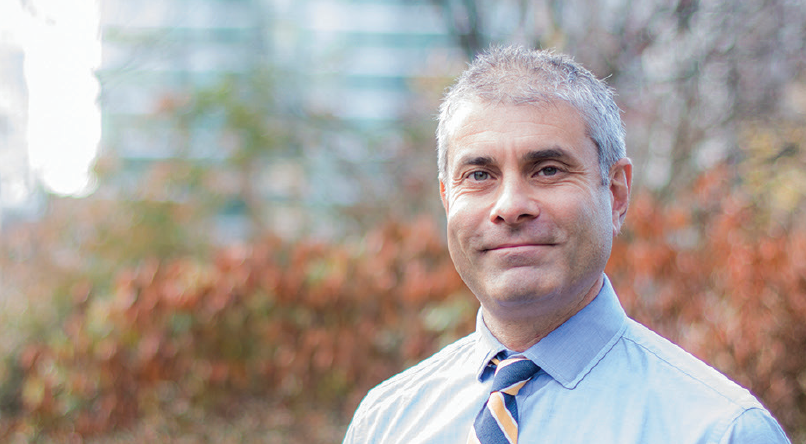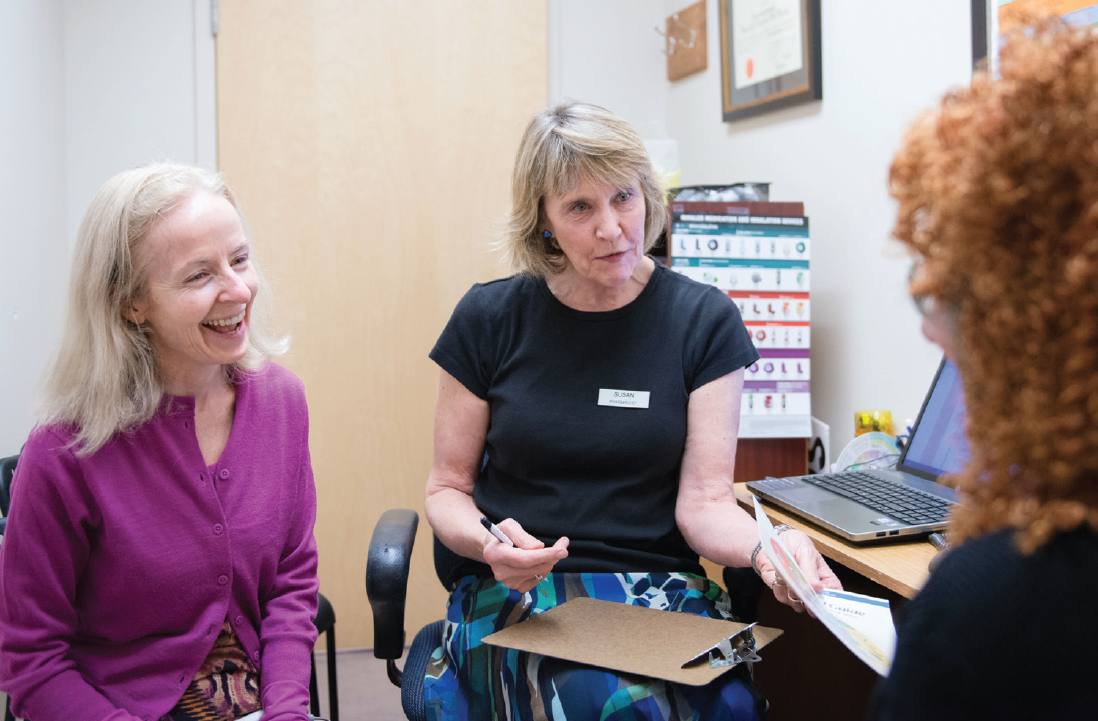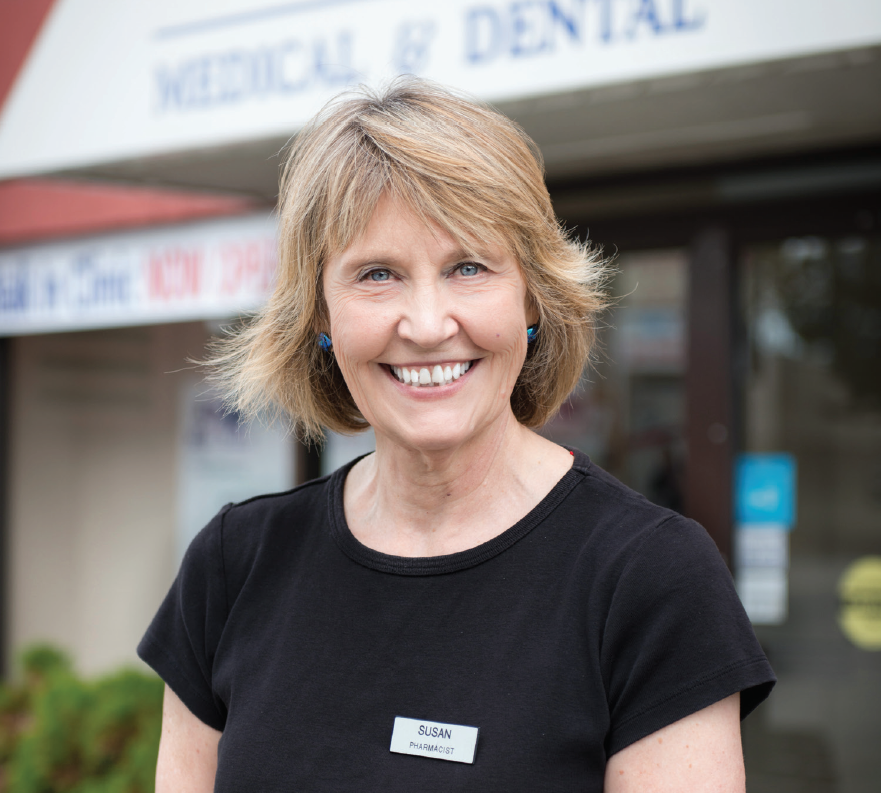As early as the 1950s, addiction care in the form of opioid maintenance treatment was on the radar of British Columbian officials. It was a simple but revolutionary concept that suggested supplying addicts with drugs to alleviate the negative criminal and health consequences of their addiction.
In 2014, there were a total of 881 pharmacies and 3,136 pharmacists in the province that provided opioid substitution treatment through methadone maintenance treatment or Suboxone.
This article takes a closer look at one new pharmacy model and a pharmacist working in a community health centre treating patients with a history of addiction.
The woman was crying when she entered the Pier Health Resource Centre pharmacy in Vancouver’s Downtown Eastside (DTES) with her husband late on a Friday afternoon. She was experiencing severe withdrawal symptoms and urgently needed Suboxone.
The woman knew she faced a weekend of heroin use if the pharmacy could not find a solution. Recognizing her distress, staff at the pharmacy took the time to examine her situation and help resolve it.
From that moment on, the couple became loyal patients at Pier Health. As time passed the husband started doing some part-time janitorial work at the pharmacy, leading him to find full-time employment elsewhere.
“He now has a job, and as a couple they are medically stable,” says Bobby Milroy, the director at Pier Health Resource Centre. “That’s a great scenario and a real win for us.”
Successful scenarios such as this can be rare in the field of addictions health care; patients’ problems are incredibly complex as they often suffer from mental health issues, chronic diseases and homelessness on top of the disease of addiction. There are many differing perspectives on how best to treat them.
Given the epidemic of opioid overdoses in BC, officials and health professionals are re-examining how the health system deals with addiction.
between staff and patients.
Pier Health Resource Centre pharmacy opened in August 2015 to address the needs of the homeless and at-risk population in the DTES by providing mental health, chronic disease and social assistance support. The pharmacy has a multi-disciplinary clinical approach with a strong emphasis on solving drug therapy problems both within the pharmacy as well as through regular outreach in the local community. Pier Health also has a part-time nurse, a massage therapist and a housing support worker for patients.
Milroy says that society is slowly changing the way it views addiction and how to treat it. “Drugs are a form of self-medication, as opposed to the exclusive problem. Our patients are not partying. It’s not fun. They are simply surviving,” he says.
In December 2013, the American Journal of Psychiatry published a UBC study titled “The Hotel Study: Multimorbidity in a Community Sample Living in Marginal Housing,” a survey of 3,000 tenants living in single-room occupancy (SRO) hotels in the DTES. Due to their affordability, SROs are often the only alternative to homelessness for low-income individuals in Vancouver and other major cities.
According to the study, two-thirds of tenants suffered from an average of three illnesses at the same time. Ninety-five per cent had substance dependence and almost two-thirds were involved in injection drug use. Nearly half of the participants suffered from psychosis, and nearly half of all participants had a neurological disorder. Eighteen per cent of the residents surveyed were HIV-positive, and 70 per cent had been exposed to hepatitis C.
Life on the streets

Dr. Keith Ahamad, an addiction physician at the St. Paul’s Addiction Medicine Consult Service, says pharmacists play a vital role in addictions care as they see patients more frequently than any other health-care provider. “It’s hugely important for pharmacists to discuss their response to medications, look at other medications they are prescribed for side effects, talk about psychosocial functioning, and act as a point of contact between the patient and the rest of the health-care team,” Ahamad says.
Life on the street is often full of trauma and violence, which can be exacerbated by medical conditions and even traumatic brain injuries. Typically, people are in a more vulnerable state so there is a much higher degree of stress. They use drugs to stay awake and other drugs to calm their anxiety. As a result, they spend more money, which in turn means they must sell medications or drugs or engage in theft or sex work to survive. That means they're more likely to be arrested or be physically assaulted. Life becomes chaotic and unpredictable.
“Patients’ situations worsen considerably when they become homeless,” Milroy explains.
Milroy says based on both the hotel study and the work of Dr. Julian Somers, an associate professor in the Faculty of Health Sciences at Simon Fraser University, medication adherence for homeless patients is nearly 40 to 50 per cent less than that of patients who have a home.
“We need to find mechanisms to effectively support these individuals, to help them achieve the best quality of life possible, and minimize their cost on society. And pharmacy has to play a part in that,” Milroy says.
If you sit in the foyer of the pharmacy during a weekday morning it almost resembles a corner coffee shop. Regulars come in to grab a free hot cup of coffee and chat with friends.
The pharmacy cultivates a safe, welcoming and stable environment and builds relationships with all local residents, regardless of whether they are customers. “Our goal is to get to know people because it’s not just medication they need,” Milroy says.
Inside the pharmacy, patients are invited to sit face-to-face with a member of the pharmacy team at one of the intake booths to discuss their medication needs and their lives.
Quality time is key

Pharmacist Susan Troesch (centre) and Dr. Lise Loubert (left) speak with a patient at the Mid-Main Community Health Centre. The centre was primarily established to treat people with several chronic conditions, mental health issues, backgrounds of addiction or long-standing chronic pain management with opioids, home-bound seniors, refugees and single parent families with lower socio-economic status. Staff help addicted patients using a more holistic approach to pain management outside of just medication.
Spending time with patients should be at the centre of addictions care, says Dr. Keith Ahamad, an addiction physician at the St. Paul’s Addiction Medicine Consult Service. He says the system has become far too reliant on medication. “We have a medical system that financially incentivizes volume rather than time spent with patients to discuss what their needs are. It is not patient centred; it’s way too health-care provider centred, and we need to spend time with these people because their problems are very complicated.”
Ahamad says pharmacists play a vital role. They see patients more frequently than any other health-care provider.
“It’s hugely important for pharmacists to discuss their response to medications, look at other medications they are prescribed for side effects, talk about psychosocial functioning, and act as a point of contact between the patient and the rest of the health-care team,” he says.
He believes increasing collaboration and communication between the whole health-care team would drastically improve care. “In particular for this complicated patient population we need to find a way to work better in teams rather than silos,” Ahamad says.
He acknowledges the huge problem of physicians overprescribing opioids and is hopeful the new professional standards on safe prescribing adopted by the College of Physicians and Surgeons of BC in June 2016 will “make doctors stop in their tracks and think about the consequences of their prescribing.”
Ahamad says pharmacists can help tackle the opioid epidemic by checking PharmaNet, flagging patients that are on excessively high doses of opioids and contacting the patient’s physician or the College if they are concerned.
While he believes the Methadone Maintenance Treatment Program in BC is effective, he feels there is huge room for improvement. This could include subsidizing medications for patients for evidence-based addictions treatment and ensuring that if pharmacists receive the extra daily witnessing fee they must spend time with their patients.
Ahamad thinks the coming years will see a shift away from methadone and towards Suboxone, as it's a simpler medication, with fewer drug interactions and a better safety profile. This will take time and education, however, as it won’t be appropriate for all patients – those who cannot tolerate the side effects of withdrawal necessary to begin Suboxone will need to remain on methadone. He says it will be important to explain to patients how the drugs work and why they’re being prescribed.
Because of the prevalence of mental illness and history of trauma, basic counselling skills are essential for pharmacists working in addictions care. “Just knowing how to be gentle and kind to this patient population is hugely important to build that therapeutic relationship, because there is so much stigma associated with addiction,” Ahamad says.
Pier Health Resource Centre places immense value on hiring pharmacists that are calm, qualified, experienced, well-trained and have an interest in ongoing education about mental health and addictions. The pharmacy has a staff of three pharmacists, a registered pharmacy technician, four part-time pharmacy assistants, a general manager/community liaison and up to four student interns at any time.
Pharmacy manager Craig Plain, who won this year’s Ben Gant Innovative Practice Award from the BC Pharmacy Association, is praised for his compassionate and personalized care.
"It's about building trust with patients and not just filling what the doctor writes," Plain says.
He can focus one-on-one with patients (often for up to 20 minutes each visit) and use the full scope of his knowledge. He's the first pharmacist in BC to administer depo anti-psychosis injections at the pharmacy through a pilot project with St. Paul’s Hospital Department of Psychiatry. The pharmacy will also be starting a clozapine program, which provides an alternative psychosis medication for patients who’ve had no success with standard treatments. The patients will also have access to a nurse who takes a weekly blood sample and monitors side effects.
There are plans to open a medical clinic above the pharmacy to help provide a comprehensive hub of services.
“We want to push the envelope and try new things," Milroy says.
This pharmacy model is expensive, but Milroy says the centre will ultimately be financially viable.
To help encourage the future sustainability of the health-care system, Pier Health shares its financials and metrics with the Ministry of Health, the College of Pharmacists of BC and the City of Vancouver.
“There is going to need to be a redesign of compensation [for pharmacists], and I want them to know exactly what is happening here,” Milroy explains. “I don’t think we’ve cracked the code yet by any means, but I do believe we have a great opportunity to contribute and to make some kind of breakthrough in the coming years.”
The power of interdisciplinary care

Susan Troesch, a pharmacist at the Mid-Main Community Health Centre, believes meeting with patients to engage them in the process is essential. “If you spend time with them, build the relationship and tell them what the expectation is then they’re pretty willing to follow your advice,” Troesch says.
At the Mid-Main Community Health Centre, pharmacist Susan Troesch works alongside the clinic’s two nurse practitioners and seven part-time physicians. The centre was established in 1988 to support the local patient population struggling to access consistent primary care. This included people living with several chronic conditions, mental health issues, backgrounds of addiction or long-standing chronic pain management with opioids, home-bound seniors, refugees and single parent families with lower socio-economic status.
When Troesch first started working at the non-profit clinic in 1999 she was seeing some patients who were struggling with addictions, some of who were living on the streets. The surrounding community has changed considerably since then to become a middle-class neighborhood. Now, none of the clinic’s patients are homeless.
In its early days, the centre operated as a salaried practice, thanks to funding from Vancouver Coastal Health (VCH). In the fall of 2014, following a VCH redesign, the clinic was transitioned to a fee-for-service funding model. This means that the physicians must bill MSP for their services to support the practice financially.
Current office visits booked with Troesch are 20 minutes and include educational support, medication reviews, development of a collaborative plan with the patient and preparation of requisitions and prescriptions. A physician joins them at the end of the visit to review and finalize the plan and sign off on any prepared documents.
These days, Troesch’s primary focus is to follow up on and manage patients with chronic conditions such as hypertension, diabetes, heart failure or COPD. However, patients are still booked with her for other reasons such as focused medication reviews, medication management issues, health promotion visits, smoking cessation support, insulin starts, follow-up regarding recent labs and prescription refills. Troesch also facilitates the group medical visits for multiple patients that happen regularly in the practice.
The centre has a common clinical room where the team sits together, which generates a lot of collaboration. “We’re advocating going back to an interdisciplinary care approach to primary care,” Troesch says. “We’ve seen the power of working face-to-face with a team, and it’s pretty hard to go back once you’ve had that experience.”
While patients struggling with addiction may be referred to an addictions specialist, the clinic does treat patients with a background of addictions, those struggling with chronic non-cancer pain and those trying to stop or reduce their use of certain medications.
“We’re doing a lot of holistic support and trying to encourage people to gradually come off opioids and benzodiazepines,” Troesch says. “That’s an area where pharmacists can be very helpful.” Benzodiazepines – which include Valium and Xanax – are used to treat conditions like anxiety, insomnia and seizures but
can cause an overdose when combined with opioids.
She remembers in the late 1990s when doctors were encouraged to treat chronic non-cancer pain using narcotics and continuing medication education courses teaching narcotic use were readily available. “Now our goal is to try and get people off narcotics because the evidence is showing us that there is a lot more risk,” Troesch says.
In fact, she says the U.S. recently reduced its maximum recommended daily dosage of morphine by more than half, from 200mg per day down to 90mg. Many of the principles recently released by the U.S. Centers for Disease Control and Prevention in the "CDC Guideline for Prescribing Opioids for Chronic Pain" were incorporated into the new College of Physicians and Surgeons of BC’s guidelines.
The College’s guidelines recommend that doctors “always prescribe the lowest effective dosage of opioid medication.” In addition, doses of morphine greater than 50mg per day “warrant careful reassessment and documentation,” and doses greater than 90mg per day “warrant substantive evidence of exceptional need and benefit.”
When a new patient requiring addiction treatment or management of non-cancer chronic pain comes to the Mid-Main Community Health Centre they are asked to sign an office narcotic agreement. Based on McMaster University’s "Canadian Guideline for Safe and Effective Use of Opioids for Chronic Non-Cancer Pain," the agreement involves a risk assessment and discussion with the patient of risk versus benefit. Patients are often booked with Troesch for this.
Troesch, the physicians and nurse practitioners talk to patients to find out about them as individuals, including their goals, how the substances they’re using are a barrier to living healthy lives and how this makes them feel. They then suggest a more well-rounded approach to pain management beyond medication. This can include strategies such as regular exercise, meditation, yoga, attending Self-Management BC programs and the importance of eating and sleeping well.
“We meet with the patient so they are engaged in the process. We find that is really important,” Troesch says. “If you spend time with patients, build the relationship and tell them what the expectation is then they’re pretty willing to follow your advice. Gradually we make a plan for titration down or off the drugs, which may take some months, depending on the individual.”
If patients do not meet the terms of their narcotic agreement, the clinic may stop prescribing them medication or refer them on, although Troesch says this is extremely rare.
The clinic does not have a dispensary onsite and patients choose a dispensing pharmacist when they sign the narcotic agreement. With permission from the patient, Troesch sends this pharmacy a copy of the agreement and asks the dispensing pharmacists to call the clinic if they have any concerns when they’re dispensing the medication or if they see prescriptions from alternate providers. “They’re part of the team too and the better the collaboration, the better it’s going to be for patient care,” she says.
While Troesch has a great relationship with the physicians and nurse practitioners at her clinic, she understands the frustration many other pharmacists feel who don’t have a good relationship with prescribers. She is adamant that the key to improving this situation is getting health-care providers face-to-face to talk about the issues, perhaps over a cup of coffee.
“There is a lot of misinformation and concern about the ‘other’ health-care providers, which doesn’t go away unless you talk about it. And this happens best face-to-face,” she says. “That’s how you make a team. And it’s team care that makes a huge difference.”
